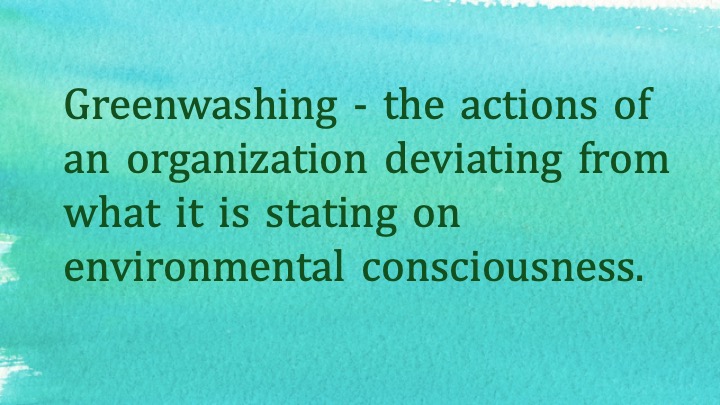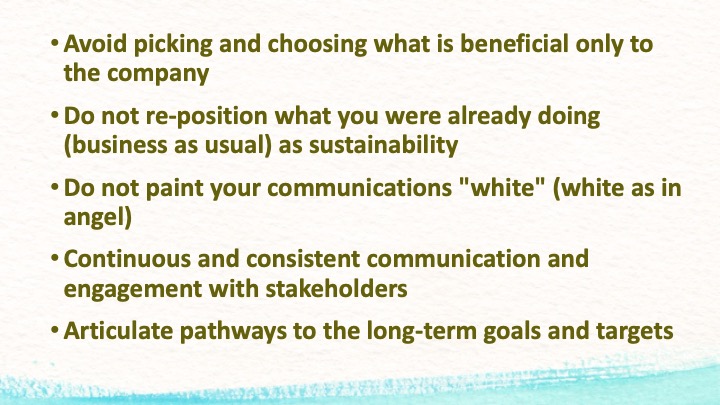The commitments made by companies around sustainability are not campaign promises politicians make, there is a much higher degree of accountability. Having said that, there is huge amount of discussion on greenwashing in recent times.
Greenwashing – the actions of an organization deviating from what it is stating on environmental consciousness.
Greenwashing can be easily understood if you look at the word’s origin. Environmentalist Jay Westerveld originally coined the term “greenwashing” in a 1986 essay criticizing the “Save the towel” campaign run by hotels[1]. The essay claimed that the hotel industry falsely promoted the reuse of towels as an environmental strategy when, in fact, the act was a cost-saving measure. He was convinced because there were no other signs of environmental consciousness in hotels, whether it is energy efficiency, waste reduction etc and hence coined the practice as greenwashing. That gives us our first clue about how we should avoid greenwashing.

1. Avoid picking and choosing what is beneficial only to the company
While there is a considerable debate in the sustainability world on single and double materiality, only picking those environmental issues that benefit the company qualifies as greenwashing. The “Save the towel” campaign by the hotel becomes greenwashing when the purpose of the hotel is dominantly to reduce the cost of operation. Jay finds that the hotel has no system to reduce other environmental impacts. Yes, there can be priority areas where the environmental impact is higher, but there has to be a management direction in all dimensions of environmental impact.
If the organization applies single materiality, it is only considering environmental risk and/or opportunity to a business, which in turn impacts its profit. It is only attending to its vulnerability to earnings. Now, that cannot be called green, or the best it can be a light shade of green.
2. Do not re-position what you were already doing (business as usual) as sustainability
If the organization tries to paint what it was already doing as a green initiative now, it will flake off (lack of primer). If all of us were doing good, we would not be in the position where we are currently. We need to accept the fact that the way we conducted ourselves till now has to change. There are many instances where organizations have tried to give a coating of green to what they already have been doing. Deliberately searching for some environmental benefits in activities that are business as usual and become loquacious about it is a clear sign of greenwashing.
There has to be a sincere way to relook at what any organization is doing. There has to be significant additionality that can showcase that the prime objective of the initiative was to create a sustainability impact.
3. Do not paint your communications “white” (white as in angel)
It may not be white lies, but it is common sense that it is challenging to operate an enterprise, and there are always plus and minus to every decision and activity. Every organization has negative environmental impacts, but the scale of impact changes. Even through a matured environment management system, the organization is trying to reduce the negative impact and improve any positive impacts. So, no one will believe you if your communications are only about the positives (White). I have repeated this many times, the best colour for sustainability communication is grey, and there are 50 shades of it.
Select a grey shade that is also transparent. There is no substitute for transparency to enable trust.

4. Continuous and consistent communication and engagement with stakeholders
This is not an annual exercise, and if done annually, it is considered a ritual. One of the common mistakes companies make in terms of communication is to publish a sustainability report and expect every stakeholder to read it. Since it is the company initiating the communication and engagement and is even responsible for selecting the channel or medium of communication, the process’s effectiveness becomes the company’s responsibility.
The communication and engagement with stakeholders should have a plan and ensure that there are no wide gaps. It should always run in continuous feedback loops.
5. Articulate pathways to the long-term goals and targets
There is a lot of discussion around some of the Net-Zero goals set by companies stating that the leaders who have set the goals are not going to be around the period when the company is supposed to reach the goal. This has resulted because the companies are still charting the pathway to these goals and the past trajectory at present is not aligned to achieve these goals. Yes, finalizing the entire road to achieving the goals is difficult because there are still technological uncertainties. But the company can clearly state its plans, break down the long-term goal, top short-term targets, and showcase its performance improvement over the short term.
Show casing that the improvements the company is making is in line with the long term goal can develop more confidence with stakeholders.
While the above five pointers can help avoid greenwashing, please also remember that there are no substitutes to a clarity of intention, purpose led decision making and transparency being a habit.
[1] https://www.aol.com/2011/02/12/the-history-of-greenwashing-how-dirty-towels-impacted-the-green/

Good Evening Mr. Santhosh Jayaram, was a pleasure reading your article. There are a lot of companies talking and moving forward on the wind and solar alternate power…but about water and conservation, there are a very few….even when it comes to water conservation they talk about storm water and Rain water which in most parts of India is seasonal and does not account even for a fraction of what us wasted….let take a small example as a sample…an organisation has 8000 employees and in their 8 hour shift will use the toilet at least twice….thats 80,000 litres of water flushed into the STP and only 60-80% recycled back that too is only used for landscaped gardens and not for any other purpose.
In the next 5 years we wont have water and that is why water has become a product of commodity on Wall Street Journal like Oil and Gold.
With the use of a “Make in India” probiotic we can achieve 95% or even 100% if it is a MBR system.
Have shared a few videos on your LinkedIn and would be glad if upon looking at the videos and the outcome…we could discuss the same at large ensuring the next generation see physical water.
Best regards.,
Balaaji Sundararaaman
CEO
Esquire Enterprise
+91 9600044822 / 9840040431
Nice 👍